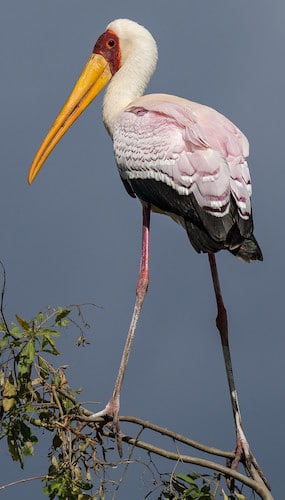Ciconiidae – Storks

The Ciconiidae or Storks are large, long-legged, long-necked wading birds with long, stout bills. They are the only family in the order Ciconiiformes, which was once much larger and held a number of families.
Storks dwell in many regions and tend to live in drier habitats than the closely related herons, spoonbills and ibises; they also lack the powder down that those groups use to clean off fish slime. Storks have no syrinx and are mute, giving no call; bill-clattering is an important mode of communication at the nest. Many species are migratory. Most storks eat frogs, fish, insects, earthworms, small birds and small mammals. There are nineteen living species of storks in six genera.
Various terms are used to refer to groups of storks, two frequently used ones being a muster of storks and a phalanx of storks.
Storks tend to use soaring, gliding flight, which conserves energy. Soaring requires thermal air currents. Storks are heavy, with wide wingspans: the Marabou Stork, with a wingspan of 3.2 metres and weight up to 8kg joins the Andean condor in having the widest wingspan of all living land birds.
Their nests are often very large and may be used for many years. Some nests have been known to grow to over two metres in diameter and about three metres in depth. Storks were once thought to be monogamous, but this is only partially true. They may change mates after migrations, and may migrate without a mate.
Storks’ size, serial monogamy, and faithfulness to an established nesting site contribute to their prominence in mythology and culture.
The centres of stork diversity are in tropical Asia and sub-Saharan Africa, with eight and six breeding species respectively. Just three species are present in the New World: Wood Stork, Maguari Stork and Jabiru, which is the largest flying bird of the Americas. Two species, White Stork and Black Stork, reach Europe and western temperate Asia, while one species, Oriental Stork, reaches temperate areas of eastern Asia, and one species, Black-necked Stork, is found in Australasia (where it is confusingly often called jabiru).
It is generally accepted that there are 19 species of storks in the family Ciconidae; they are:
Wood Stork Mycteria americana
Milky Stork Mycteria cinerea
Yellow-billed Stork Mycteria ibis
Painted Stork Mycteria leucocephala
Asian Openbill Anastomus oscitans
African Openbill Anastomus lamelligerus
Black Stork Ciconia nigra
Abdim’s Stork Ciconia abdimii
Woolly-necked Stork Ciconia episcopus
Storm’s Stork Ciconia stormi
Maguari Stork Ciconia maguari
White Stork Ciconia ciconia
Oriental Stork Ciconia boyciana
Black-necked Stork Ephippiorhynchus asiaticus
Saddle-billed Stork Ephippiorhynchus senegalensis
Jabiru Jabiru mycteria
Lesser Adjutant Leptoptilos javanicus
Greater Adjutant Leptoptilos dubius
Marabou Stork Leptoptilos crumeniferus
-
Painted Stork Mycteria leucocephala
IUCN Species Status -
Painted Stork Mycteria leucocephala
Species AccountSound archive and distribution map. -
Painted Stork Mycteria leucocephala
Species AccountThe painted stork (Mycteria leucocephala) is a large wader in the stork family. It is found in the wetlands of the plains of tropical Asia south of the Himalayas in the Indian Subcontinent and extending into Southeast Asia. Their distinctive pink tertial feathers of the adults give them their name. -
White Stork Ciconia ciconia
IUCN Species Status -
White Stork Ciconia ciconia
Species AccountSound archive and distribution map. -
White Stork Ciconia ciconia
Species AccountThe white stork (Ciconia ciconia) is a large bird in the stork family Ciconiidae. Its plumage is mainly white, with black on its wings. Adults have long red legs and long pointed red beaks. -
Wood Stork Mycteria americana
Species AccountSound archive and distribution map. -
Wood Stork Mycteria americana
Species AccountThe wood stork (Mycteria americana) is a large American wading bird in the stork family Ciconiidae. It was formerly called the "wood ibis", though it is not an ibis. -
Wood Stork Mycteria americana
Cornell Species AccountA large, white, bald-headed wading bird of the southeastern swamps, the Wood Stork is the only stork breeding in the United States -
Yellow-billed Stork Mycteria ibis
BirdLife Species AccountBirdLife species account… -
Yellow-billed Stork Mycteria ibis
IUCN Species Status -
Yellow-billed Stork Mycteria ibis
Species AccountSound archive and distribution map. -
Yellow-billed Stork Mycteria ibis
Species AccountSpecies account....
-
Number of bird species: 19
-
Schwarzstorch (Black Stork)
Burmeister, G Schroeder, P, Westarp Wissenschaften 2004 ISBN: 3894322195 Buy this book from NHBS.com
-
White Storks nest online camera POLAND
WebsiteWhite Storks nest online camera with up to 18x optical zoom - Przygodzice, Barycz Valley, South Wielkopolska region, Poland…
